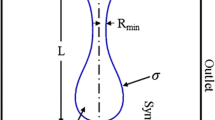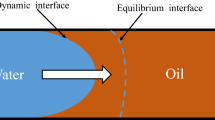Abstract
Two-phase flow in a capillary with different radii is a fundamental phenomenon in many sciences and engineering applications. A tilted pore-throat structure is designed to study a drop flow through an abruptly constricted capillary under gravity/microgravity. The theoretical models for the flow time, total resistance pressure drop and the required minimal applied pressure for a drop passing through an abruptly constricted capillary under gravity/microgravity are derived, and the relationships among them are discussed and analyzed comprehensively. It is found that the total resistance pressure and the required minimal applied pressure for a drop passing an abruptly constricted capillary under gravity/microgravity depend on the pore-throat ratio, inclination angle, contact angle and the diameter of the smaller capillary. The present model predictions are compared with available experimental data in the literature, and good agreement is found between them. The theoretical models may have the potential in many sciences and technologies.









Similar content being viewed by others
References
Bayareh M, Doostmohammadi A, Dabiri S, Ardekani AM (2013) On the rising motion of a drop in stratified fluids. Phys Fluids 25:103302
Cai JC, Hu XY, Standnes DC, You LJ (2012) An analytical model for spontaneous imbibition in fractal porous media including gravity. Colloids Surf A 414:228–233
Cai JC, Perfect E, Cheng CL, Hu XY (2014) Generalized modeling of spontaneous imbibition based on Hagen-Poiseuille flow in tortuous capillaries with variably shaped apertures. Langmuir 30:5142–5151
Dangla R, Lee SY, Baroud CN (2011) Trapping microfluidic drops in wells of surface energy. Phys Rev Lett 107:124501
Das S, Mitra SK (2013) Different regimes in vertical capillary filling. Phys Rev E 87:063005
Das S, Waghmare PR, Mitra SK (2012) Early regimes of capillary filling. Phys Rev E 86:067301
Deng DX, Tang Y, Zeng J, Yang S, Shao HR (2014) Characterization of capillary rise dynamics in parallel micro V-grooves. Int J Heat Mass Transf 77:311–320
Denn MM (1980) Process fluid mechanics. Prentice-Hall, NJ
Dietrich N, Loubiere K, Jimenez M, Hebrard G, Gourdon C (2013) A new direct technique for visualizing and measuring gas–liquid mass transfer around bubbles moving in a straight millimetric square channel. Chem Eng Sci 100:172–182
Fisher LR, Lark PD (1979) An experimental study of the Washburn equation for liquid flow in very fine capillaries. J Colloid Interface Sci 69:486–492
Gao HJ, Yu BM, Duan YG, Fang QT (2014) Fractal analysis of dimensionless capillary pressure function. Int J Heat Mass Transf 69:26–33
Goldsmith HL, Mason SG (1963) The flow of suspensions through tubes. II. Single large bubbles. J Colloid Sci 18:237–261
Hemmat M, Borhan A (1996) Buoyancy-driven motion of drops and bubbles in a periodically constricted capillary. Chem Eng Commun 148:363–384
Howard JA, Walsh PA, Walsh EJ (2011) Prandtl and capillary effects on heat transfer performance within laminar liquid-gas slug flows. Int J Heat Mass Transf 54:4752–4761
Hu WR, Xu SC (1999) Micro-gravity fluid mechanics. Science Press, Beijing
Huang JJ, Huang HB, Wang XZ (2014) Numerical study of drop motion on a surface with stepwise wettability gradient and contact angle hysteresis. Phys Fluids 26:062101
Kang K, Koelling K (2004) Void transport in resin transfer molding. Polym Compos 25:417–432
Kashid MN, Kowaliński W, Renken A, Baldyga J, Kiwi-Minsker L (2012) Analytical method to predict two-phase flow pattern in horizontal micro-capillaries. Chem Eng Sci 74:219–232
Legait B (1983) Laminar flow of two phases through a capillary tube with variable square cross-section. J Colloid Interface Sci 96:28–38
Li KW, Horne RN (2009) Experimental study and fractal analysis of heterogeneity in naturally fractured rocks. Transp Porous Media 78:217–231
Lu YC, Xia Y, Luo GS (2011) Phase separation of parallel laminar flow for aqueous two phase systems in branched microchannel. Microfluid Nanofluid 10:1079–1086
Lundström TS (1996) Bubble transport through constricted capillary tubes with application to resin transfer molding. Polym Compos 17:770–779
Lundström TS, Frishfelds V, Jakovics A (2010) Bubble formation and motion in non-crimp fabrics with perturbed bundle geometry. Compos Part A 41:83–92
Peña TJ, Carvalho MS, Alvarado V (2009) Snap-off of a liquid drop immersed in another liquid flowing through a constricted capillary. AIChE J 55:1993–1999
Ransohoff TC, Gauglitz PA, Radke CJ (1987) Snap-off of gas bubbles in smoothly constricted noncircular capillaries. AIChE J 33:753–765
Sherwood JD, Xie YB, van den Berg A, Eijkel JCT (2013) Theoretical aspects of electrical power generation from two-phase flow streaming potentials. Microfluid Nanofluid 15:347–359
Shih CH, Lee LJ (2002) Analysis of void removal in liquid composite molding using microflow models. Polym Compos 23:120–131
Shou DH, Ye L, Fan JT, Fu KL (2014a) Optimal design of porous structures for the fastest liquid absorption. Langmuir 30:149–155
Shou DH, Ye L, Fan JT (2014b) Treelike networks accelerating capillary flow. Phys Rev E 89:053007
Shou DH, Ye L, Fan JT (2014c) The fastest capillary flow under gravity. Appl Phys Lett 104:231602
Smith WO, Crane MD (1930) The Jamin effect in cylindrical tubes. J Am Chem Soc 52:1345–1349
Tsai TM, Miksis MJ (1997) The effects of surfactant on the dynamics of bubble snap-off. J Fluid Mech 337:381–410
Waghmare PR, Mitra SK (2012) A comprehensive theoretical model of capillary transport in rectangular microchannels. Microfluid Nanofluid 12:53–63
Wang XY, Riaud A, Wang K, Luo GS (2014) Pressure drop-based determination of dynamic interfacial tension of droplet generation process in T-junction microchannel. Microfluid Nanofluid. doi:10.1007/s10404-014-1449-0
Washburn EW (1921) The dynamics of capillary flow. Phys Rev 17:273–283
Acknowledgments
This work was supported by the National Natural Science Foundation of China through Grant No. 10932010.
Author information
Authors and Affiliations
Corresponding author
Rights and permissions
About this article
Cite this article
Liang, M., Yang, S., Miao, T. et al. Minimum applied pressure for a drop through an abruptly constricted capillary. Microfluid Nanofluid 19, 1–8 (2015). https://doi.org/10.1007/s10404-014-1541-5
Received:
Accepted:
Published:
Issue Date:
DOI: https://doi.org/10.1007/s10404-014-1541-5




